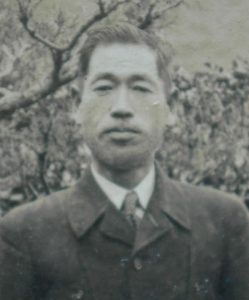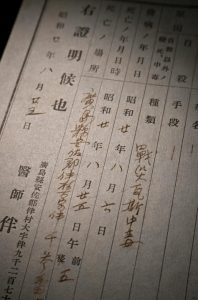Documenting Hiroshima of 1945: August 25, death certificates indicated “gas poisoning”
Aug. 25, 2024
by Maho Yamamoto, Staff Writer
The physician Fuyuki Ban examined many survivors over a series of days following the atomic bombing, writing death certificates for the dead at his medical clinic in the village of Tomo in Hiroshima Prefecture (now part of Hiroshima City’s Asaminami Ward), around nine kilometers northwest of the hypocenter. He wrote “war gas poisoning” on the death certificate of a 22-year-old male soldier, who died on August 25, 1945.
His oldest son, Toshihiko Ban, 90, said, “Ponds and rivers turned black because of black rain, and dead fish floated up to the surface. He might have thought that the bomb had emitted poisonous substances or gases.” Toshihiko is also a physician and lives in Hiroshima’s Asaminami Ward. He was a sixth-grader at a national school at the time of the atomic bombing. He remembers his late father examining people who had lined up to be seen by him at the clinic from early in the morning until late at night. He reflects deeply about his father’s trouble facing the unknown damage caused by the bombing.
The death certificates for 52 people who died between August 6 and September 16 written by Mr. Ban still exist today. The most common causes of death in the immediate aftermath of the atomic bombing were “death from burns in war” and “death from fire in war.” Six people died of “war gas poisoning” during the period August 15–27, when the number of deaths among people who had suffered only light injuries was increasing due to acute effects from A-bomb radiation. Toshihiko said, “It must have taken time for information about radiation to reach my father. I think he continued to struggle not knowing why people were dying.”
Lives could not be spared despite his dedicated efforts. In his personal notes, which were included in The History of the Asa Medical Association, published in 1985, Mr. Ban wrote of his disappointment. “I did not know what A-bomb sickness was. I was in a fog and unable to provide the treatment for symptoms that I had hoped to give, resulting in many deaths of my fellow countrymen and women.” He added, “I regret I was unable to provide enough treatment because of shortages in materials and a sudden increase in the number of seriously wounded. All I can do is pray for the repose of the souls of the dead.”
(Originally published on August 25, 2024)
The physician Fuyuki Ban examined many survivors over a series of days following the atomic bombing, writing death certificates for the dead at his medical clinic in the village of Tomo in Hiroshima Prefecture (now part of Hiroshima City’s Asaminami Ward), around nine kilometers northwest of the hypocenter. He wrote “war gas poisoning” on the death certificate of a 22-year-old male soldier, who died on August 25, 1945.
His oldest son, Toshihiko Ban, 90, said, “Ponds and rivers turned black because of black rain, and dead fish floated up to the surface. He might have thought that the bomb had emitted poisonous substances or gases.” Toshihiko is also a physician and lives in Hiroshima’s Asaminami Ward. He was a sixth-grader at a national school at the time of the atomic bombing. He remembers his late father examining people who had lined up to be seen by him at the clinic from early in the morning until late at night. He reflects deeply about his father’s trouble facing the unknown damage caused by the bombing.
The death certificates for 52 people who died between August 6 and September 16 written by Mr. Ban still exist today. The most common causes of death in the immediate aftermath of the atomic bombing were “death from burns in war” and “death from fire in war.” Six people died of “war gas poisoning” during the period August 15–27, when the number of deaths among people who had suffered only light injuries was increasing due to acute effects from A-bomb radiation. Toshihiko said, “It must have taken time for information about radiation to reach my father. I think he continued to struggle not knowing why people were dying.”
Lives could not be spared despite his dedicated efforts. In his personal notes, which were included in The History of the Asa Medical Association, published in 1985, Mr. Ban wrote of his disappointment. “I did not know what A-bomb sickness was. I was in a fog and unable to provide the treatment for symptoms that I had hoped to give, resulting in many deaths of my fellow countrymen and women.” He added, “I regret I was unable to provide enough treatment because of shortages in materials and a sudden increase in the number of seriously wounded. All I can do is pray for the repose of the souls of the dead.”
(Originally published on August 25, 2024)









